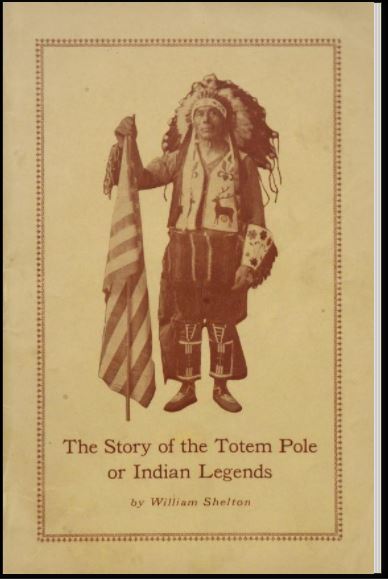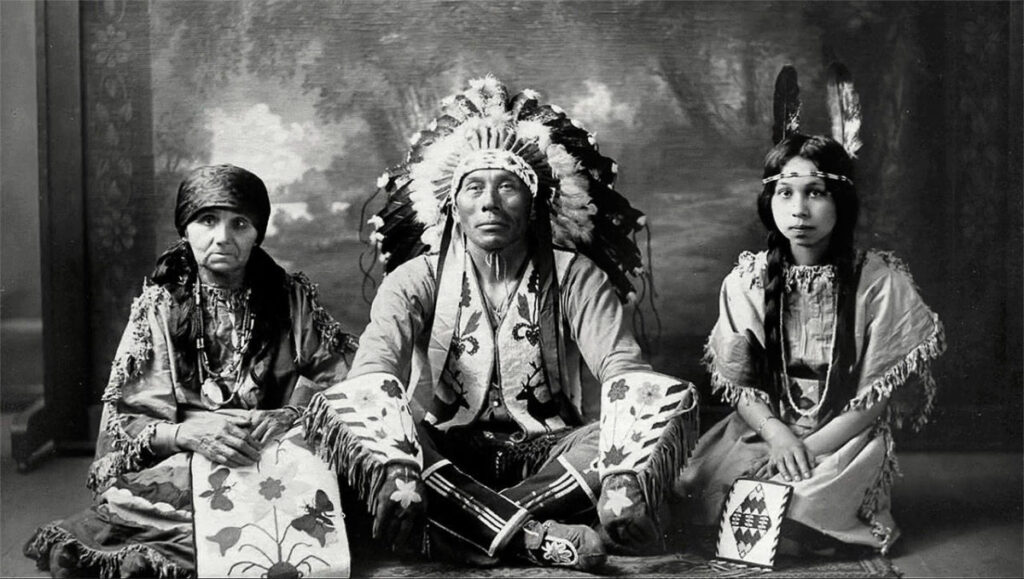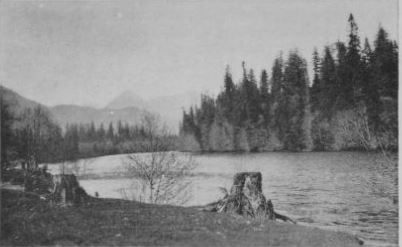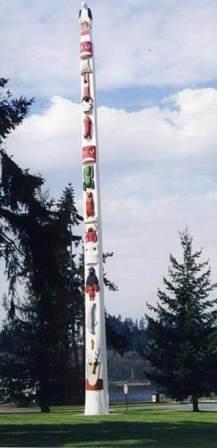The Raven and The Fish Hawk
By Chief William Shelton/Wha-Cah-Dub (Snohomish)[1]
Annotations by Jessica cory

On the banks of a beautiful river lived a Raven and a Fish-Hawk and as they were neighbors they were very friendly and congenial. Now, as winter drew near and the fish in the river became scarce and food of all kinds was very
difficult to find, they began to experience some rather hard times. The fish-hawk was noted for his skill in fishing and he was also known for his honesty and truthfulness throughout the country, while on the other hand, the raven was unskilled and poor and a great deceiver. This the Fish-Hawk did not know and he always believed that his neighbor, the Raven, was a very good man.
The winter became even more severe and the Raven found very little food indeed, in fact, he was very nearly starving to death. The Fish-Hawk, however, did not fare quite so badly for although the fish in the river were scarce he managed to get enough to keep him comfortably in food. He would climb a tree one limb of which overhung the river and then would let himself fall down on the ice, breaking through it and so enabling him to get at the fish. It required great skill to do this stunt, but then we know that the Fish-Hawk was very skillful.

The Fish-Hawk was under the impression all this time that his neighbor was getting along quite well, until one day he heard that the Raven was starving to death. Fish-Hawk walked around the bend to his neighbor’s house that day to see for himself how the Raven was getting along and he found that it was really true that the Raven was starving to death, so he invited the Raven over to his house the next day for a feast. The Raven was greatly pleased with the invitation and the next morning he made ready for his visit and started off bright and early. As he approached the house of his neighbor he noticed particularly how beautiful everything seemed and how well taken care of the grounds were. The Raven came to the house and was very cordially received by the Fish-Hawk. Here the Raven began to look around for something to eat, for he had not eaten anything for several days and was feeling rather weak. To his dismay, he could see no food and he began to wonder why he had been called over to the house of the Fish-Hawk if the Fish-Hawk had no food for him; yet he noticed that the Fish-Hawk built his fire and made ready for the feast. Then he bade the Raven sit down close to the fire so that he might warm himself. The Fish-Hawk then excused himself and went out doors; the Raven watched him and saw that he went down to the stream, that he climbed a tall tree, one limb of which was overhanging the river, and when he reached this limb and got away out on the end of it he sang a weird song that the Raven could not understand. Then suddenly he saw the Fish-Hawk fall as if he were dead, right down on the ice, right through the ice, and the Raven was certain that he had been killed at once. The Raven ran to the edge of the river, but could find no trace of the Fish-Hawk until after a few seconds he saw him come up from under the ice with a number of trout. Of course the Raven was greatly surprised at this new way of fishing and decided he would like to try it himself. So after the Fish-Hawk had given him a feast and the Raven had all he could possibly eat, he started back home again and invited the Fish-Hawk over to his house for a feast the next day.
The next day Mr. Fish-Hawk went over to the Raven’s house and as he entered the place he was aware of the fact that there was no food anywhere in sight, yet he felt quite sure that the Raven would not have asked him to visit him if he had no food at all. He watched the Raven carefully and saw that he built the fire and then walked out of the house. The Fish-Hawk wondered what he was going to do; he saw the raven climb a high tree growing close to the river. When he reached the top of the tree, the Fish-Hawk heard him singing and his song sounded very much like the one the Fish-Hawk himself had used the day before, so the Fish-Hawk was certain that the Raven could do just as he did. When the Raven finished his song he permitted himself to fall down swiftly and he hit the ice with a great thud, but did not break through the ice as the Fish-Hawk had done and so when he landed on the ice all the bones in his body were broken and he died instantly.

The Fish-Hawk, who was watching from the window in the house could not see down to the river and did not know that the Raven had been killed; he thought that the Raven was as skilled in doing this stunt as he himself was and therefore he waited to see the Raven come up towards the house with a catch of fish. After he waited for him several minutes he suspected some evil, so he walked down to the creek and there he discovered the broken body of the Raven. It made the Fish-Hawk feel very badly that his neighbor was killed just because he was foolish enough to try to do this trick and so he tried his best to bring him to life again. He picked up the pieces and placed them together and then he sang and danced around them until the raven finally came back to life. The Raven looked up and said: “Why, I must have been asleep for quite a time,” but the Fish-Hawk told him that he had not been asleep, but dead, adding: “I did not think that you were foolish enough to try to perform such a dangerous stunt as you must have known that you were unable to do it. In the future, you want to be sure you know how to do a thing before you try it.” Then he carried the Raven up to his house and came down to the stream again. He climbed the tree from which the Raven had fallen and after singing his great song, he let himself fall to the ice, breaking through it and after a second or two he came up with several fine fish. These he took up to the Raven’s house and left them there so that the Raven might have food while he was recovering from his fall.
Mr. Fish-Hawk went home that day very much disgusted with his neighbor, the Raven. He had discovered that the Raven was not a great man at all, but merely a fraud, and he was greatly disappointed in him.
Now the lesson part of this story is that one should not attempt to do the impossible; if you know you are not qualified to do certain things, do not try to do them just because you see someone else doing them, and so cause others to laugh at you and call you a fool. Test your strength, your power, your knowledge, and then act accordingly!
Shelton, William. “The Raven and the fish hawk.” The Story of the Totem Pole or Indian legends. (Everett, Wash., Kane & Harcus co., printers, 1923), 60-63. [3]
[1] The Snohomish Tribe are a people whose ancestral territory is in the Puget Sound area of Washington. Currently, the Tribe is not recognized by the state or federal governments. Many Snohomish have joined the federally recognized Tulalip Tribe, which is comprised of “direct descendants of and the successors in interest to the Snohomish, Snoqualmie, Skykomish, and other allied bands signatory to the 1855 Treaty of Point Elliott.” Because Chief Shelton was not enrolled in the Tulalip Tribe, I have identified him as Snohomish. According to this source, the spelling of “Snohomish” in Lushootseed, the language spoken by the Snohomish, is ‘Sdoh-doh-hohbsh.’ However, I’ve kept it as “Snohomish” in this case, as the traditional spelling is not commonly used.
[3] No publication location was provided. Additionally, an alternate title (or perhaps a subtitle) appears on the inside title page: The Story of the Totem Pole: Early Indian Legends As Handed Down from Generation to Generation Are Herewith Recorded by William Shelton of Tulalip. While Chief Shelton was not enrolled in the Tulalip Tribe, he did live in the Tulalip, WA area.
Contexts
Chief Shelton was also a master carver, creating many story poles (sometimes called spirit poles). Often these poles are carved from cedar and depict tribal stories used to teach lessons to youth. For additional information on Chief Shelton’s carvings, see the “Contemporary Connections” section below.
Not much scholarship has been written on Chief Shelton, particularly on the stories that comprise this book. One source that discusses his depictions of Native children is the article “Reading into the Voice: The Representation of Native Voices in Three Early Twentieth-Century Children’s Story Collections” by Melinda Li Sheung Ying. Ying’s article can be found in Knowing Their Place? Identity and Space in Children’s Literature, edited by Terri Doughty and Dawn Thompson, published by Cambridge Scholars in 2011.
Margaret Riddle provides additional biographical information about Chief Shelton’s life.
Resources for Further Study
- For information on the Snohomish Tribe, please look at their tribal website.
- The Tulalip Tribes’ website is especially helpful for understanding the differences and similarities in the Tulalip and Snohamish Tribes.
- The Washington Governor’s Office of Indian Affairs provides the full text of the Treaty of Point Elliott, 1855, which resulted in the ceding of Native lands in Washington State. It’s important to remember the power dynamics and structures at play between the U.S government and Tribal Nations at the times many of these treaties were ratified.
- Alexa Koenig and Joshua Stein explain the differences between state-recognized and federally-recognized tribes. Essentially, for federal recognition, a tribe has to prove that’s it has existed in an uninterrupted fashion for hundreds of years. However, federal and state policies since contact have made this difficult to prove for many tribes.
- Gabriel Furshong explains why some tribes remain unrecognized by state or federal entities.
Pedagogy
Many lesson plans that focus on totem poles are, frankly, terrible and encourage cultural appropriation. Make sure that if you’re teaching about totem/spirit/story poles that you include education about what they are, what they represent, and how they are important to specific tribes.
- The Puyallup School District has lots of activities and lesson plans for teaching about the tribes inhabiting what is now Washington State.
Contemporary Connections
In 2010, Shelton’s massive 71-foot story pole, “Lifting the Sky,” (pictured below) was removed from the Capitol grounds in Olympia due to fear of rot and potential injury. It appears to still be in storage, though the Burke Museum in Seattle has shown interest and there is also talk to returning it to the Tribe.

Another of his story poles, a 36-foot work of art displayed at Krape Park, Illinois was also removed in 2008 and is now housed at the Burke Museum in Seattle, WA, waiting its next move. The Burke Museum features a discussion of his work as a carver and the inspiration for his work. In 2018, a biographical documentary was made of Shelton’s daughter, Harriette “Hiahl-tsa” Shelton Dover (pictured earlier).